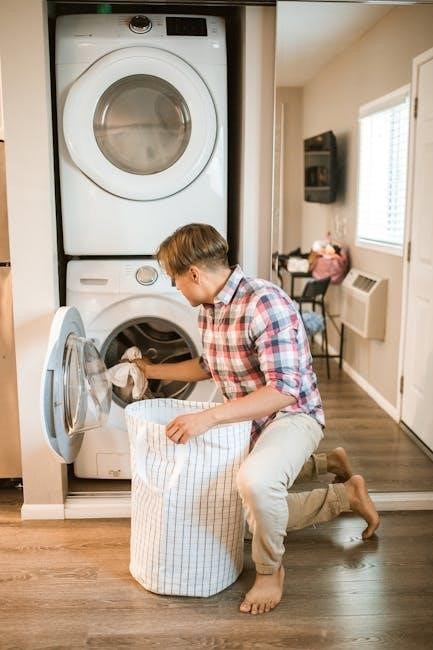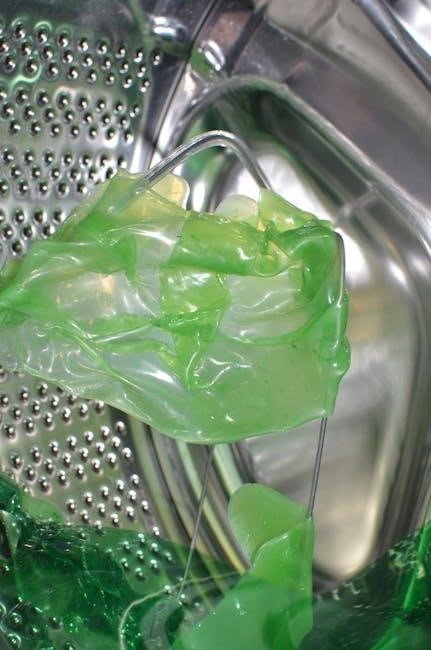Siemens Washing Machine User Guide: A Comprehensive Overview
This guide provides a detailed overview of Siemens washing machines, offering instructions for optimal use. You’ll find information on operation, maintenance, troubleshooting, and maximizing your machine’s performance for superior laundry care.
Understanding Your Siemens Washing Machine
Siemens washing machines are renowned for their cutting-edge technology, energy efficiency, and user-friendly features. Before you begin using your Siemens washing machine, it’s crucial to understand its key components and functionalities. This section will guide you through the essential aspects of your appliance.
Familiarize yourself with the control panel, which allows you to select various wash programs and settings. Each program is designed for specific fabric types and soil levels. Understanding these programs will ensure optimal cleaning results while protecting your garments.
Furthermore, explore the machine’s various features, such as the speedPack L for quicker washes and the iQdrive motor for efficient and quiet operation. The user manual provides detailed explanations of each feature, helping you leverage the full potential of your Siemens washing machine.
Pay close attention to the safety instructions outlined in the manual to ensure safe and proper operation. Understanding these guidelines will prevent accidents and prolong the life of your appliance. Remember to register your product online to access exclusive services and offers.

Getting Started: Initial Setup and Installation
Proper installation is key for optimal performance. This section guides you through connecting the water supply, drainage, leveling, and positioning your Siemens washing machine, ensuring a smooth and efficient start.
Connecting Water Supply and Drainage
Ensuring a proper water supply and drainage connection is crucial for the reliable operation of your Siemens washing machine. First, locate the water inlet valve at the back of the machine. Connect the water supply hose, typically blue for cold water, securely to both the valve and the faucet. Ensure the hose is not kinked or twisted.
Next, address the drainage system. The drain hose should be connected to a standpipe or laundry sink. Make sure the connection is secure to prevent leaks during operation. The drain hose should not be inserted too far into the standpipe to avoid siphoning issues. A height of approximately 60-90 cm from the floor is generally recommended.
Before proceeding, check all connections for leaks by running a short test cycle. Observe the water inlet and drain connections carefully. If leaks are detected, tighten the connections or replace the hoses if necessary. Proper connections will prevent water damage and ensure your washing machine functions efficiently.
Leveling and Positioning the Machine
Proper leveling and positioning are essential for minimizing vibration and noise during operation. Start by placing the Siemens washing machine on a firm, level surface. Use a spirit level to check the machine’s horizontal and vertical alignment; If the machine is not level, adjust the adjustable feet located at the bottom corners.
Loosen the locking nuts on the feet, then rotate the feet to raise or lower each corner until the machine is perfectly level. Once leveled, tighten the locking nuts against the machine’s base to secure the feet and prevent movement. Ensure all four feet are in contact with the floor for optimal stability.
After leveling, gently push down on each corner of the machine to ensure it doesn’t rock or wobble. If it does, repeat the leveling process until the machine is stable. Adequate leveling reduces vibration, noise, and potential damage to the machine and surrounding areas, contributing to quieter and more efficient operation.

Operating Your Siemens Washing Machine
Learn how to effectively operate your Siemens washing machine. This section covers navigating the control panel, selecting wash programs, adding detergents, and utilizing special features for optimal cleaning results.

Navigating the Control Panel and Settings
Understanding your Siemens washing machine’s control panel is crucial for efficient operation. Familiarize yourself with the symbols, buttons, and display screen. Many models feature intuitive interfaces with program selection dials or touch-screen controls. The display usually shows the selected program, temperature, spin speed, and remaining time.
Explore the various settings to customize your wash cycles. Adjust temperature settings according to fabric type, from cold washes for delicates to hot washes for heavily soiled items. Select the appropriate spin speed to balance drying time and garment care. Higher spin speeds extract more water but can wrinkle delicate fabrics.
Utilize special options like pre-wash, intensive wash, or eco-mode to optimize cleaning performance and energy consumption. Some models offer features like speedPack L to shorten program durations or stain removal systems to target specific stains effectively. Refer to your user manual for detailed explanations of each setting and its impact on the wash cycle. Proper navigation ensures optimal cleaning and garment care.
Selecting the Appropriate Wash Program
Choosing the right wash program is vital for effectively cleaning your clothes while preserving their quality. Your Siemens washing machine offers a range of programs designed for different fabric types and soil levels. Consult the user manual to understand each program’s specific purpose and settings.
For everyday laundry, the “Cottons” program is suitable for durable cotton garments. Use the “Synthetics” program for synthetic fabrics like polyester or nylon. Delicate items, such as silk or lingerie, require the “Delicates” or “Hand Wash” program, which uses gentle agitation and lower temperatures.
Specialized programs cater to specific needs. The “Wool” program is designed for woolens, preventing shrinkage and damage. “Outdoor/Waterproof” is ideal for technical clothing, preserving water-repellent properties; For lightly soiled items, the “Quick/Mix” program offers a fast wash cycle. Heavily soiled items may benefit from the “Intensive” program or pre-wash option. Selecting the correct program ensures optimal cleaning and prolongs the life of your garments.
Adding Detergent and Fabric Softener Correctly
Proper detergent and fabric softener usage is crucial for effective cleaning and fabric care. Your Siemens washing machine features a dispenser drawer with compartments for detergent, fabric softener, and sometimes pre-wash detergent. Refer to your machine’s manual for the specific layout.
When adding detergent, use the appropriate amount based on the load size, soil level, and water hardness. Too much detergent can leave residue, while too little may result in inadequate cleaning. Use high-efficiency (HE) detergent for HE machines to prevent excessive suds. Pour the detergent into the compartment marked for the main wash.
Add fabric softener to the designated compartment, typically marked with a flower symbol. Do not overfill, as this can cause dispensing issues. Fabric softener should be diluted automatically during the final rinse cycle. Avoid using fabric softener with certain fabrics, like microfiber or sportswear, as it can reduce their absorbency. Following these guidelines will ensure optimal cleaning and fabric care.

Maintenance and Troubleshooting
This section covers essential maintenance tasks for your Siemens washing machine. It also provides troubleshooting tips to address common issues and understand error codes, ensuring long-lasting performance and efficient operation.
Cleaning and Caring for Your Washing Machine
Proper cleaning and care are crucial for maintaining the efficiency and longevity of your Siemens washing machine. Regular cleaning prevents the build-up of detergent residue, mold, and other debris that can affect performance and cause unpleasant odors. Clean the detergent dispenser regularly to prevent clogs.
The washing machine drum should also be cleaned periodically. Run an empty cycle with a washing machine cleaner or a solution of vinegar and baking soda to remove residue. Wipe down the door seal after each use to prevent mold growth.
Inspect and clean the filter regularly to remove lint and small objects that can clog the drain pump. Descale the machine periodically, especially if you live in an area with hard water. Following these simple steps will keep your Siemens washing machine running smoothly and efficiently for years to come.
Addressing Common Issues and Error Codes
Siemens washing machines are designed for reliability, but occasional issues may arise. Understanding common problems and error codes can help you troubleshoot effectively. If the machine won’t start, check the power supply and door lock. For drainage problems, inspect the drain hose and filter for blockages. Excessive noise during operation may indicate an unbalanced load or a foreign object in the drum.
Error codes displayed on the control panel provide valuable diagnostic information. Consult your user manual for a comprehensive list of error codes and their corresponding solutions. Some common error codes relate to water supply issues, motor malfunctions, or sensor failures.
If you’re unable to resolve the issue yourself, contact Siemens customer support or a qualified appliance repair technician. Provide the model number and error code for efficient assistance. Regular maintenance can help prevent many common problems.


